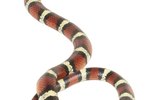
Captive snakes may soak in their water bowls from time to time, causing anxiety for pet owners. While this is generally no cause for concern, it's important to investigate the reason your snake is soaking, Some species soak frequently as part of their natural behavior, but it can also indicate health or husbandry problems that must be addressed.
Why Snakes Soak in Their Water Bowls
Snakes soak on their own for a number of reasons, though occasionally the reason may be hard to determine. Animals from tropical locations require high relative humidity, and if this drops too low they may seek comfort through soaking in the water dish. Water snakes (Nerodia sp.) and anacondas (Eunectes sp.) are semi-aquatic in the wild, and will swim and soak in the water dishes often -- provide these species with a water bowl large enough to permit comfortable soaking. If a snake’s cage is too hot, the snake may use his water bowl to cool off. Snakes with mites may seek relief from the irritation in their water bowl. Finally, stressed snakes are known to use their water bowl as a hiding place if no better one is available.
Proper Soaking Technique
When soaking a snake, use a translucent plastic storage tub about the size of the snake’s hiding box. Ventilate the top by drilling a few small holes, and be sure it closes securely. Use enough room-temperature water to raise the water level about halfway up the animal’s body -- in other words, a snake that is 2 inches tall should have 1 inch of water. Never leave a soaking snake unattended; snakes can drown, and you must be able to intervene if the animal struggles. If the animal may be dehydrated, soak it in plain water; when animals are soaked to address shedding problems or to eradicate mites, a slightly soapy mixture should be used.
Mites
Mites are small, ectoparasites of snakes and lizards. While a handful of mites may not harm a snake, they quickly multiply in captivity and should be eradicated immediately when they're detected. Mites drown if they get wet; unfortunately, mites can hide in the small air pockets under the snake’s scales, inside the vent and in the fold under the chin. Thus, even if your snake soaks on its own, some mites are always sure to live. To combat this, add a drop of gentle, non-scented dish detergent to the soaking container -- this will break the water’s surface tension, allowing the water to better penetrate the mites’ refuges. Several hours of soaking is generally long enough to kill the mites on the snake; the cage and all furnishings must be discarded or sterilized while the snake is soaking. It usually takes more than one round of soaking and cage cleaning to eradicate all the mites.
Shedding
Sometimes snakes will have an incomplete shed, and some or most of the old skin may remain attached to the snake. When this happens, the best remedy is to soak the snake is slightly soapy water for a few hours. The time spent in the water will help to loosen the skin; if it doesn’t come off on its own, you can gently work the shed portions free, but do not force any skin that doesn’t release easily. Don’t touch the snake’s eye caps if they do not shed properly -- you can soak the snake repeatedly for a few days to see if they will come off on their own. If they remain attached, take your snake to a qualified vet for assistance.
References
Photo Credits
-
Tom Brakefield/Stockbyte/Getty Images




